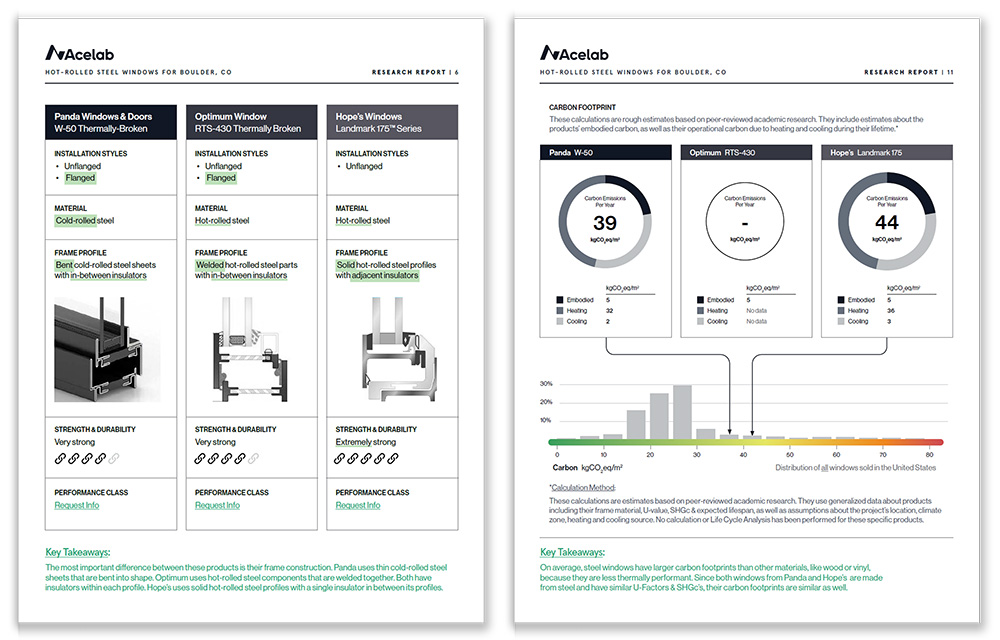What did architects research in 2023, and what's important in 2024?
Sustainability and durability were top-of-mind for architects on Acelab in 2023. We saw a huge number of product requests, project questions, and material research done for sustainable cladding and insulation, durability in building products, and EPD's. We're already seeing these research areas growing in 2024, especially for EPD's (Environmental Product Declarations).
These documents aren't new, but they're gaining traction as an important tool for architects concerned about sustainability. EPD's cover a lot of information, so we're breaking down how to read and evaluate them in this article.
EPD's: one trend to carry forward from 2023 to 2024.
You would not buy a car without kicking the tires, slamming the door, and reading the sticker in the window. You should not spec a building product without doing the same. An EPD is the sticker in the window for specifying a product, when there is one available, reading it can give you all the information you need in one place. A complete EPD includes production performance information as well as the key LCA (Live Cycle Analysis) which makes these such a popular tool.
Here's some useful tips to help extract action items from the EPD which you are reviewing. We'll go through each of the key topics covered in an EPD:
Carbon Footprint (including embodied energy and global warming potential)
Resource Depletion
Acidification
Eutrophication
Human Health Impacts

Sample Page of Brick Industry Average EPD
EPD’s are a popular tool in sustainable architecture for good reason.
What is an EPD (Environmental Product Declaration)?
One important aspect of improving the sustainability of the built environment is transparency and knowledge. EPD’s are a declaration by a product manufacturer of the impact of their product. They are verified by an independent 3rd party and published in a standard format.
EPD’s are a tool which have been around since 2000, and provide an understanding of the impact of building materials. Every product and process has an impact, and we want to use the EPD to compare the products used on projects, and select the lowest impact option available while still meeting all of our other requirements.
Think of them as nutrition labels for building materials, supplying you with crucial information on aspects such as CO2 emissions, energy usage, water consumption, and more.
Product Category EPD’s vs. Product Specific EPD’s
Before you start evaluating an EPD, you have to check which flavor it is. EPD's come in two flavors: Product Specific and Product Category (Industry Average). Both are useful but you're likely to use them differently.
The ISO standards (ISO 14025) for EPD’s have been around for 23 years, but they’ve only gained widespread traction in the last 5 years or so, largely due to LEED's evolving requirements. EPD’s are getting even more popular in 2024 as more architects become aware of their usefulness. There’s still some frustrating gaps, but knowing how to leverage EPD’s can help you make better sustainability decisions.
Product category EPD’s are useful for making early design decisions, such as brick vs. metal at the concept design stage.
Product specific EPD’s are useful for making targeting product choices later in the design process; should we use Dow, Soprema or Owens?
The Role of EPD’s In Sustainable Design Choices
EPD’s are vital tools for architects, builders, and designers aiming for sustainability. By utilizing these declarations:
-
Architects make informed decisions about the materials you select, and their environmental impact.
-
Manufacturers are encouraged to reduce their environmental impact.
-
Complying with green building standards is more straightforward.
By integrating standardized data from EPD’s into your project planning, you ensure that your material choices align with sustainable practices.
While comparing EPD’s for building products, keep in mind that not all EPD use the same quantities. Based on PCR's (Product Category Rules, found in ISO 21930) each product has a recommended unit to use, such as a whole window for windows or a bucket of paint for paint. But it's not practical or possible to always use the exact same unit from manufacturer to manufacturer, and especially not between different materials. For that reason, we recommend limiting how much you use the number data to places where direct comparison is possible, such as carbon emissions from two product declarations using the same quantity. Look for key indicators for your particular product.
Different EPD categories will help you at different design phases. For example, in early design decisions, you can use Product Category EPD’s to make comparisons between materials before design decisions are made. You're going to be looking at all the categories at a high level -
-
Carbon Footprint - lower is better
-
Resource Depletion - responsible sourcing and recycling is better
-
Acidification and Eutrophication - less water use and pollution is better
-
Human Health Impacts - where lower toxicity is better.
By understanding how to use EPD’s thoughtfully through your design process, you can influence the sustainability of your project from the get-go.
Understanding EPD’s: Carbon Footprint
Let's start with a closer look at Carbon Footprint reduction, since it’s likely the easiest place to start comparing EPD’s. Carbon is the scientifically accepted standard measure for global warming and air pollution, and as we all know, lower is better. In EPD’s, the carbon footprint is broken down by phase. Broadly speaking, the phases are:
-
Manufacturing
-
Construction
-
Operations
-
Recycling
Only the Manufacturing phase is required to be reported, so don't be surprised if you're missing the others. The first question to ask yourself, and the EPD, is what phase is likely to generate the most impact for a given product.
The simple example here is insulation vs. mechanical equipment. The insulation takes energy to make, so check out its Manufacturing phase. The mechanical equipment takes energy to operate, so check out its Operations phase. A red flag might be missing data for an important phase for a specific product. When you're reading your first few EPD’s, it's easy to get overwhelmed by the numbers. Is 3.67E+00 CO2 good or bad? But don't worry, the key is to find the smallest number between the products you’re evaluating. Smaller is better.

Looking for Products with EPD's?
Acelab's advanced search can help you find & compare building products for any project. Learn More
Ask an Expert about EPD's for CladdingEPD’s are a popular tool in sustainable architecture for good reason.
What is an EPD (Environmental Product Declaration)?
One important aspect of improving the sustainability of the built environment is transparency and knowledge. EPD’s are a declaration by a product manufacturer of the impact of their product. They are verified by an independent 3rd party and published in a standard format.
EPD’s are a tool which have been around since 2000, and provide an understanding of the impact of building materials. Every product and process has an impact, and we want to use the EPD to compare the products used on projects, and select the lowest impact option available while still meeting all of our other requirements.
Think of them as nutrition labels for building materials, supplying you with crucial information on aspects such as CO2 emissions, energy usage, water consumption, and more.
Understanding EPD’s: Resource Depletion
The next category is Resource Depletion, where Responsible Sourcing and Recycled Content are the indicators to look out for.
For example, two products might both source metal as a raw material, but one might get that metal only from mining while the other might use 20% recycled metal. 20% might not seem like much, but it is better than zero.
For another product you might be comparing 100% recycled content vs 80% recycled content. Keep in mind that looking at a group of EPD's gives you a sense of what is the best option available in the current market and will be different from category to category. For things like forestry and mining, look for 3rd party certifications such as FSC Chain of Custody Certification for sustainably sourced lumber or IRMA Certification for large scale mining.
Acidification and Eutrophication
Acidification and Eutrophication are primarily a problem for our oceans, lakes, and waterways which in turn impact our entire ecosystems health. This may seam hard to capture in an EPD, but again, the disclosures are there and you can look our for key indicators to make an informed decision about a materials impact. By a large margin, the largest cause of water acidification is atmospheric carbon, so any product with high carbon emissions will have a negative impact. The main cause of Eutrophication is chemical runoff into rivers, largely from agriculture but also from industrial sources. After looking for low emissions, look for low water use. The shortcut for water use is recycling which uses less water that sourcing virgin material. For example, copper, which is mostly commonly used in architectural products, has been used and recycled for 10,000 years but currently in the US only 42% is recycled (compared to 65% in Europe and 45% globally). That's meaningful since recycled metal uses as little as 1% of the water of mining metals.
Human Health
The final impact which can be assessed with an EPD is Human Health. Similar to a MSDS (Material Safety Data Sheet), an EPD presents information which you have to evaluate to determine the level of toxic exposure for folks making, installing, and living with the product. The great thing about an EPD is that you have all the ingredients in one place. The hard part is that you will still need to check those ingredients to see what their health impacts are. Check the ingredients against standard lists such as the ILFI Materials Red List and keyword search for VOC's (Volatile Organic Compounds) and POP's (Persistent Organic Pollutants). Remember that even though some products may only impact users if they are installed on the interior of a project they can still harm workers making them or building the project.

Sample page for a Joint Sealant, Sikaflex-1a Product Specific EPD
Example Product EPD for building joint sealant.
We're happy to see users requesting and searching for EPD on Acelab and expect that trend to continue. EPD are not a quick answer, but they give you information all in one place to make informed, sustainable, product selections. You can consider the Embodied Energy, Material Resource Use, Pollution, and Recycling and combine that with project specific information which isn't in a declaration but you know: What is the expected lifespan of the project? What products will be installed together with this product? What end of life options are available for construction products in your area?
Consider EPDs as part of your next product search.

